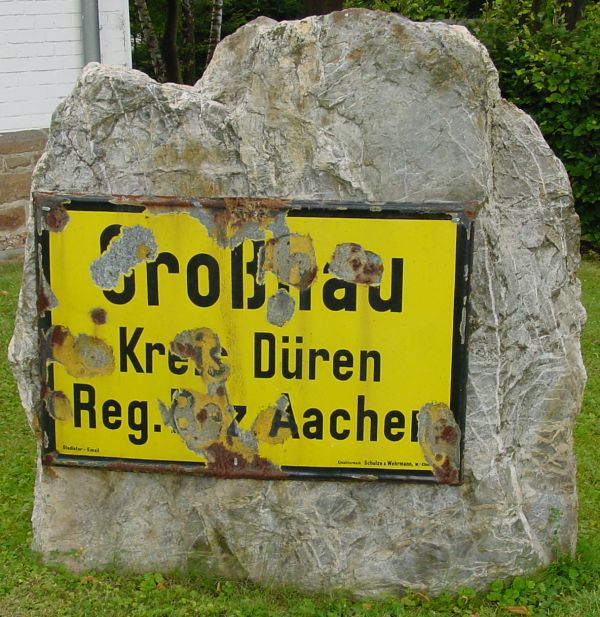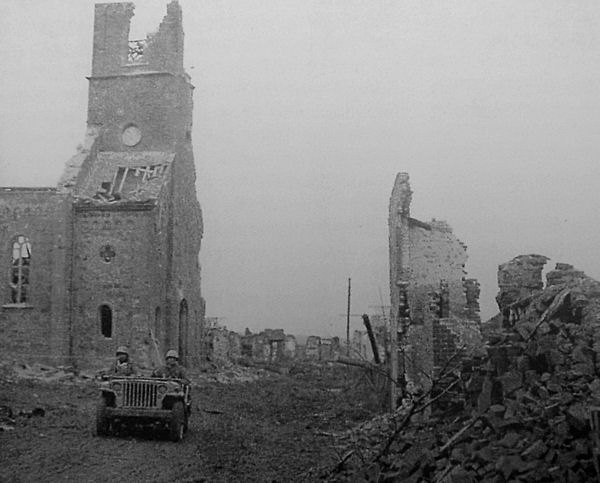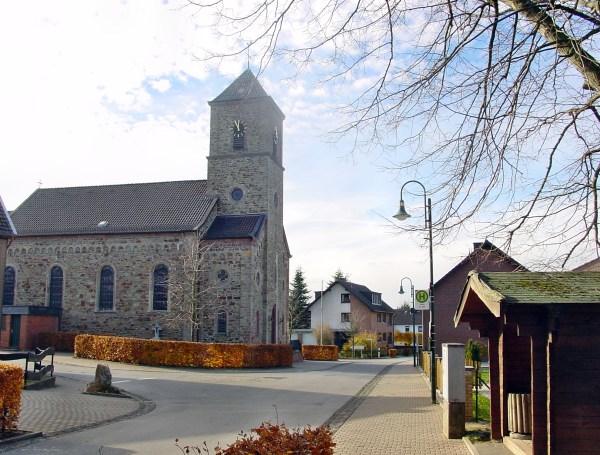CHAPTER V
Attack of GROSSHAU by the 22nd Infantry
On D-Day the 22nd Infantry Regiment in the center had been assigned the task of capturing GROSSHAU. (F052581) After many days of hard slow fighting, on 23 November the regiment reached the edge of the woods facing the town and here consolidated their positions. On 24 November replacements were received bringing the regiment up to strength, and it was decided to attack the town of GROSSHAU on the following day
The regimental commander desired surprise in his attack and, therefore, ordered the 3rd Battalion of the regiment to envelope from the north without artillery preparation. The 1st battalion was to cover the left rear west of GROSSHAU, while the 2nd was to make a secondary attack to the edge of the woods southwest of the town.

Company C, 70th Tank Battalion, was to support the 3rd Battalion in its attack. This company had been working with the 22nd since 16 November. On Saturday morning, 25 November, Captain Lewis Taynton in command of Company C, moved his tanks into positions to support the attack. The Germans greeted their movement into the attack position with heavy concentrations of artillery and mortar fire which caused many casualties among the infantry. At 1000 the 2nd tank platoon had to find a new attack position to the northwest since the infantry company which had been, with them was reduced to four men. At 1115 the 13 remaining tanks and the 3rd platoon of Company C, 803rd TD Battalion jumped off in the attack on GR0SSHAU. This was scheduled to be a coordinated attack, but because of the terrific volume of artillery fire very few of the infantry were able to clear the edge of the woods. The tank company commander reported seeing only six men and one infantry officer. (4) The terrain between the woods and the town was open, rolling ground and almost immediately the tanks and TDs (employed as tanks) were fired upon by well placed anti-tank guns. Six of the tanks and two destroyers were knocked out by direct hits. The remaining destroyers and tanks withdrew to the edge of the forest, but there the rearward movement was stopped by fallen trees which artillery and anti-tank guns had knocked down. Trees fell across the top, in front, and sometimes in rear of the tanks. In the opinion of the company commander every tank was eventually hit either by direct or indirect fire of some kind. All the armor was forced to stay in the edge of the woods until nightfall when the trees were cleared away. One more tank was lost during the night by a hit from a large caliber artillery shell.
Meanwhile Company C of the 709th tank battalion (which had arrived from V Corps the day before) supported the limited objective attack of the 2nd Battalion southwest of GROSSHAU. The battalion secured its objective late in the afternoon.
Since there was no longer any chance of a surprise attack on GROSSHAU, the village was shelled. The regiment decided to wait until the 12th Regiment and the 5th Armored Division (V Corps) came abreast. The regimental commander ordered tanks and destroyers to withdraw and assemble further back because as long as the tanks remained in the front lines they drew artillery, mortar, and anti-tank fire.
The day following the ill fated attack on GROSSHAU, a task force was formed from Company C, 70th Tank Battalion, Company C, 709th Tank Battalion, and Company C, 803rd Battalion. This force was attached to the 70th under the nominal command of the battalion executive officer, and it was sent to support the 2nd battalion of the 22nd Regiment facing GROSSHAU in the woods southwest of the town. During the day the group was moved into position to support the infantry. The tanks and TDs fired on enemy positions in the town of GROSSHAU and KLEINHAU; they were subjected to enemy artillery fire all day but held their positions.
For the next two days the task force poured fire on enemy positions in and around the town, from the sector of the 2nd battalion, which extended from the east-west road leading into GROSSHAU south about 1000 yards. One German self-propelled AT gun was knocked out when one of the sharp-eyed tank commanders of the 70th noticed movement in the woods south of town. The area between the woods and the town was heavily mined with AT and AP mines, but because of the artillery and small arms fire covering these mines it was impossible for engineers to move forward to clear them. The dominating ridge in this locality ran through KLEINHAU and east of GROSSHAU toward GEY. The possession of this high ground enabled the enemy to cover GROSSHAU and its western approaches, and to keep the 22nd Regiment under devastating direct fire.
While waiting for V Corps troops to come abreast, the regimental commander of the 22nd decided on a plan to bypass GROSSHAU to the north in the direction of GEY. This move together with the advance of V Corps through KLEINHAU would encircle GROSSHAU. On Wednesday, 29 November, the plan was put in operation. The 2nd Battalion continued to hold west and southwest of GROSSHAU while the 1st and 3rd advanced north-east toward GEY. Just before noon the division commander disapproved the plan and ordered that GROSSHAU be taken that day. The only battalion in position to make an immediate attack on the town was the 2nd.
The hastily formed plan called for the infantry to advance followed by the tanks and destroyers of the task force. At 1500 the attack was launched, but almost immediately the infantry was pinned down by heavy concentrations of enemy fire. The tanks and tank destroyers then attempted to push out ahead of the infantry. The 1st platoon of Company C, 70th Tank Battalion, which was leading attempted to breach the minefield. Two of the tanks struck mines and were knocked out. The remaining three tanks pushed out following closely the tracks of the first two and successfully broke through the mines. The company commander was following closely in his command tank and the four tanks arrived in the town almost at the same time as three TDs. The infantry of the 2nd battalion followed rapidly and eliminated the snipers in the cellars of the town.
During the attack destroyers of Company C, 803rd TD Battalion, neutralized two pill boxes and two machine gun nests by direct fire. They killed about 50 of the enemy and took 45 prisoners who were passed over to the infantry on arrival. The third platoon of this company gave direct fire support to the attack by firing HE, AP, and caliber .50 from their original positions.
By 1900 GROSSHAU was completely in American hands, and the armor began to withdraw for refueling and re-supply. This was accomplished by sending a few back at a time. As the last tank cleared the mine field on its way back the enemy detonated a large portion of the field by remote control, but no one was hurt. The 2nd Battalion set up its CP for the night in the only building in GROSSHAU even partially standing, using the basement which had been converted into a bomb shelter by the Germans. The tanks and TDs returned to the town as they were refueled and went into a defensive position outposting the town for the night.
After the fall of GROSSHAU the next objective of the 22nd Regiment was the wooded area between GROSSHAU and GEY. The armored task force formed by the three C Companies supported the infantry in the attack to the northeast and succeeded in either taking or controlling all of the open ground north and east of the town. (For action of 5th Armored Division in this area, see Chapter VII.)

A jeep of the 22nd Infantry passes through the ruined town of Grosshau.


